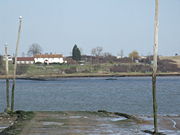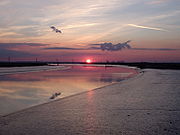
The Swale
Encyclopedia

Kent
Kent is a county in southeast England, and is one of the home counties. It borders East Sussex, Surrey and Greater London and has a defined boundary with Essex in the middle of the Thames Estuary. The ceremonial county boundaries of Kent include the shire county of Kent and the unitary borough of...
from the Isle of Sheppey
Isle of Sheppey
The Isle of Sheppey is an island off the northern coast of Kent, England in the Thames Estuary, some to the east of London. It has an area of . The island forms part of the local government district of Swale...
.
History

The Swale was originally part of a river. Prior to the formation of the English Channel
English Channel
The English Channel , often referred to simply as the Channel, is an arm of the Atlantic Ocean that separates southern England from northern France, and joins the North Sea to the Atlantic. It is about long and varies in width from at its widest to in the Strait of Dover...
in about 6500 BC, the eastern coast of Great Britain
Great Britain
Great Britain or Britain is an island situated to the northwest of Continental Europe. It is the ninth largest island in the world, and the largest European island, as well as the largest of the British Isles...
extended much further into the area of the present-day North Sea
North Sea
In the southwest, beyond the Straits of Dover, the North Sea becomes the English Channel connecting to the Atlantic Ocean. In the east, it connects to the Baltic Sea via the Skagerrak and Kattegat, narrow straits that separate Denmark from Norway and Sweden respectively...
, and the Isle of Sheppey formed part of mainland Britain. The channel now occupied by the Swale comprised a river valley facing eastwards. As sea-levels rose, water occupied the whole length of the valley, dividing today's Isle of Sheppey from the mainland.
When the Romans
Ancient Rome
Ancient Rome was a thriving civilization that grew on the Italian Peninsula as early as the 8th century BC. Located along the Mediterranean Sea and centered on the city of Rome, it expanded to one of the largest empires in the ancient world....
arrived in Britain, the Swale extended much wider than it does today, with one part of the Isle of Sheppey — now called the Isle of Harty — a separate island. The Isle of Harty is no longer separate but the marshlands now gradually filling the channel delineate it. The channel needs constant dredging to allow use of the busy waterway.
The Swale is crossed at its western end by two bridges: the Kingsferry Bridge
Kingsferry Bridge
The Kingsferry Bridge is a combined road and railway vertical-lift bridge connecting the Isle of Sheppey to Kent in the South East England. It was designed by Mott, Hay and Anderson, and built by John Howard, with Dorman Long and Sir William Arrol...
and the later Sheppey Crossing
Sheppey Crossing
The Sheppey Crossing is a four-lane road bridge which crosses The Swale at a height of 35m , linking the Isle of Sheppey with mainland Kent...
.
Nature


National Nature Reserve
For details of National nature reserves in the United Kingdom see:*National Nature Reserves in England*National Nature Reserves in Northern Ireland*National Nature Reserves in Scotland*National Nature Reserves in Wales...
and a Special Protection Area
Special Protection Area
A Special Protection Area or SPA is a designation under the European Union Directive on the Conservation of Wild Birds.Under the Directive, Member States of the European Union have a duty to safeguard the habitats of migratory birds and certain particularly threatened birds.Together with Special...
: the eel grass
Zostera
Zostera is a small genus of widely distributed seagrass, commonly called marine eelgrass or simply eelgrass . The genus Zostera contains sixteen species.-Ecology:Zostera is found on sandy substrates or in estuaries submerged or partially floating...
, Ray's knotgrass, white seakale
Seakale
Crambe maritima is a halophytic perennial plant in the genus Crambe that grows wild along the coasts of Europe, from the North Atlantic to the Black Sea. It has large fleshy glaucous collard-like leaves and abundant white flowers...
, glasswort
Glasswort
Salicornia is a genus of succulent, halophyte plants that grow in salt marshes, on beaches, and among mangroves. Salicornia species are native to North America, Europe, South Africa, and South Asia...
s and golden samphire
Golden samphire
The Golden samphire is a perennial coastal species, which may be found growing on salt marsh or sea cliffs across Eurasia....
support rare and uncommon migrant butterflies
Butterfly
A butterfly is a mainly day-flying insect of the order Lepidoptera, which includes the butterflies and moths. Like other holometabolous insects, the butterfly's life cycle consists of four parts: egg, larva, pupa and adult. Most species are diurnal. Butterflies have large, often brightly coloured...
and moth
Moth
A moth is an insect closely related to the butterfly, both being of the order Lepidoptera. Moths form the majority of this order; there are thought to be 150,000 to 250,000 different species of moth , with thousands of species yet to be described...
s, including the Essex emerald
Essex Emerald
The Essex Emerald is a moth of the Geometridae family . It is distributed throughout the Palearctic region with records from many European countries. The British subspecies Thetidia smaragdaria maritima was last seen in 1991 and is now feared to be extinct. In 2004 the first record from Sweden was...
, the ground lackey, the clouded yellow butterfly and rare hawk-moths.
Birds
The Swale notably provides habitats for the following birds:- AvocetAvocetThe four species of Avocets are a genus, Recurvirostra, of waders in the same avian family as the stilts.Avocets have long legs and long, thin, upcurved bills which they sweep from side to side when feeding in the brackish or saline wetlands they prefer...
Recurvirostra avosetta at least 17 percent of Great Britain's breeding population - Marsh HarrierMarsh harrierThe marsh harriers are birds of prey of the harrier subfamily. They are medium-sized raptors and the largest and broadest-winged harriers. Most of them are associated with marshland and dense reedbeds...
Circus aeruginosus at least 15 percent of Great Britain's breeding population - Mediterranean GullMediterranean GullThe Mediterranean Gull, Ichthyaetus melanocephalus, is a small gull which breeds almost entirely in Europe, mainly in the south east, especially around the Black Sea, and in central Turkey. There are colonies elsewhere in southern Europe, and this species has undergone a dramatic range expansion in...
Larus melanocephalus - Bar-tailed GodwitBar-tailed GodwitThe Bar-tailed Godwit is a large wader in the family Scolopacidae, which breeds on Arctic coasts and tundra mainly in the Old World, and winters on coasts in temperate and tropical regions of the Old World...
Limosa lapponica - Eurasian Golden PloverEurasian Golden PloverThe European Golden Plover is a largish plover. This species is similar to two other golden plovers. American Golden Plover, Pluvialis dominiica, and Pacific Golden Plover, Pluvialis fulva, are both smaller, slimmer and relatively longer-legged than European Golden Plover, and both have grey...
Pluvialis apricaria - Hen HarrierHen HarrierThe Hen Harrier or Northern Harrier is a bird of prey. It breeds throughout the northern parts of the northern hemisphere in Canada and the northernmost USA, and in northern Eurasia. This species is polytypic, with two subspecies. Marsh Hawk is a historical name for the American form.It migrates...
Circus cyaneus - Ringed PloverRinged PloverThe Common Ringed Plover or Ringed Plover is a small plover.Adults are 17-19.5 cm in length with a 35–41 cm wingspan. They have a grey-brown back and wings, a white belly, and a white breast with one black neckband. They have a brown cap, a white forehead, a black mask around the eyes...
Charadrius hiaticula - Black-tailed GodwitBlack-tailed GodwitThe Black-tailed Godwit, Limosa limosa, is a large, long-legged, long-billed shorebird first described by Carolus Linnaeus in 1758. It is a member of the Limosa genus, the godwits...
Limosa limosa islandica - Grey PloverGrey PloverThe Grey Plover , known as the Black-bellied Plover in North America, is a medium-sized plover breeding in arctic regions. It is a long-distance migrant, with a nearly worldwide coastal distribution when not breeding....
Pluvialis squatarola - KnotRed KnotThe Red Knot, Calidris canutus , is a medium sized shorebird which breeds in tundra and the Arctic Cordillera in the far north of Canada, Europe, and Russia. It is a large member of the Calidris sandpipers, second only to the Great Knot...
Calidris canutus - PintailNorthern PintailThe Pintail or Northern Pintail is a widely occurring duck which breeds in the northern areas of Europe, Asia and North America. It is strongly migratory and winters south of its breeding range to the equator...
Anas acuta - Common RedshankCommon RedshankThe Common Redshank or simply Redshank is an Eurasian wader in the large family Scolopacidae.- Description and systematics :...
Tringa totanus - ShovelerShovelerThe shovelers, formerly known as shovellers, are four species of dabbling ducks with long, broad spatula-shaped beaks:* Red Shoveler, Anas platalea* Cape Shoveler, Anas smithii* Australasian Shoveler, Anas rhynchotis...
Anas clypeata
External links
- English Nature page
- Description of Special Protection Area
- Map sources for

